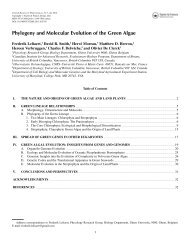DICTYOTALES, PHAEOPHYCEAE - Phycology Research Group ...
DICTYOTALES, PHAEOPHYCEAE - Phycology Research Group ...
DICTYOTALES, PHAEOPHYCEAE - Phycology Research Group ...
Create successful ePaper yourself
Turn your PDF publications into a flip-book with our unique Google optimized e-Paper software.
1282OLIVIER DE CLERCK ET AL.topologies with enforced monophyly of one of thegenera turned out to be significantly worse than theobtained ML tree (Fig. 5). The highly homoplasticnature of vegetative characters becomes even moreevident when mapped on the molecular phylogenythat incorporates only the Dictyoteae with Scoresbyellaas out-group (Fig. 6). A multilayered medullary structure,the defining character of the genus Dilophus, isseen to have evolved independently on several occasions.Nevertheless, a broad tendency for members ofthe tribe to display a multilayered medulla in the basalclades and to move toward a unilayered medulla in themore derived taxa can be observed. Medullary thicknessis shown to be heterogeneous and thus not to beuseful as a diagnostic character of genera delineation.Some species are characterized by a medulla comprisedof several layers over the entire width in themiddle and proximal parts of the thallus but with aunilayered or only marginally multilayered medullaabove (e.g. Dil. fastigiatus, Dil. gunnianus, Dil. robustus,Dil. spiralis, Dil. suhrii; Hamel 1939, Phillips 1992,De Clerck 2003). In other species, duplications of themedullary layer are effectively restricted to themargins over the entire length of the thallus, exceptperhaps at the extreme basal parts (e.g. Dil. alternans,Hörnig et al. 1992a, b). In Dil. fasciola and Dil. crenulatusthe medulla is uniformly unilayered except for thelowermost basal portion, where it becomes two to threelayers thick (Feldmann 1937, Nizamuddin and Gerloff1979).Duplications of medullary cells often coincide withthe means of attachment, as several of such species areattached by terete stoloniferous holdfasts, whereasthose with monostromatic medullas are anchored bybasal discs or scattered rhizoids. Transverse sections ofstoloniferous holdfasts always seem to reveal a multilayeredmedulla (De Clerck 2003, p. 137, Fig. 51E). Acloser look at the structure of the transition zone betweentendrils and the expanded fronds above, however,reveals that the traditional distinction betweenmedullary and cortical cells is not as obvious as hasbeen assumed. The parenchymatous nature of thestoloniferous holdfast is the result of divisions in boththe cortical and medullary layers (De Clerck and Coppejans2003). Apart from those structural duplications,an occasional two-layered medulla is commonly observedin many species. Actually, just about any speciesseems capable of locally producing a two-layered medullain the expanded fronds. Moreover, the numberof medullary layers seems at least to some degree influencedby external conditions, as culture experimentshave shown that this feature depends on theculture medium in several species (Hörnig et al.1992a).Similarly, the structure of the cortex in members ofthe Dictyoteae is highly homoplasious. Even within thelong-standing genus Pachydictyon, the term ‘‘multilayeredcortex’’ encompasses a wide variety of corticalstructures, ranging from species characterized by acortex that is essentially unilayered but with the oddcortical cell duplication in the basal parts of the thallus(e.g. P. aegerrime, Allender and Kraft 1983) to speciescharacterized by a cortex 10–12 cells thick (P. coriaceum,Okamura 1899). Occasional duplication of corticalcells, especially along the thallus margins, is a fairlycommon phenomenon among the more robust Dictyotaor Dilophus species and has generally been given littleor no attention, with the noteworthy exception of Dawson’s(1950) study of Mexican Pacific Dictyoteae. Phillips(1992) illustrated duplicated cortex cells in severalDilophus species, but did not further remark on thecharacter. An interesting example of cortical variabilityis D. naevosa, in which the cortex may become up totwo to six cells thick in the proximal parts (Womersley1987). Why it should have remained in Dictyota in lightof this classically determinative feature, however, hasnever been discussed.Surface proliferations are restricted to a few species,but they are distributed among all of the establishedgenera of the Dictyoteae. However, the high density ofsurface proliferations observed in Glossophora andGlossophorella is usually not encountered in the othergenera. Comparably high densities have, however,been observed in Dil. intermedius (Allender and Kraft1983), but in this species these proliferations neverbear reproductive structures as is occasionally observedin Glossophora (Womersley 1987). In D. crispata,D. cervicornis, and D. mertensii, surface proliferationdensity varies greatly. One should differentiatebetween surface proliferations as outgrowths fromthe vegetative tissue and those that are the resultof the in situ germination of sporangia. The lattercondition has been discussed in detail for Dil. fasciolaby Feldmann (1937), who ascribed it to and apomeioticdevelopment of spore mother cells. In fact, in situ germinationof sporangia is a widespread phenomenonrecorded for many species, among them D. dichotoma,the generitype of Dictyota (Hwang et al. 2005).As opposed to the apparent limited taxonomic utilityof the aforementioned vegetative characters, mappingof additional characters on the molecular tree(Fig. 6) does result in clear-cut patterns that can formthe basis of a new classification. The presence ofaberrant antheridial paraphyses was first reported forD. magneana (Coppejans et al. 2001) and later forD. crispata (De Clerck 2003). Paraphyses associatedwith antheridia are a common feature in the Dictyotales,and the different types are considered to be importantdiagnostic characters at the genus level(Phillips 1997, Phillips and Clayton 1997). In all Dictyoteaefor which male reproductive structures areknown, the antheridia are surrounded by three to sixrows of unicellular, elongated cortical cells devoid ofchloroplasts. The inner row of paraphyses (i.e. theparaphyses bordering the antheridia) is of the sameheight as the antheridia. The paraphyses observed inD. crispata and D. magneana differ not only in beingmulticellular and pigmented, but also in overtoppingthe peripheral antheridia. Other differences includethe fact that the antheridial sori in Dictyota are gener-
















